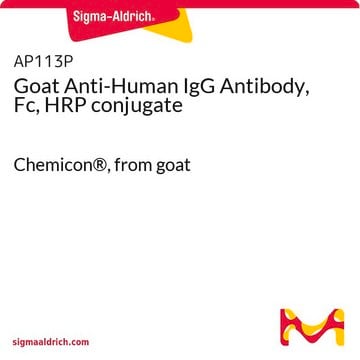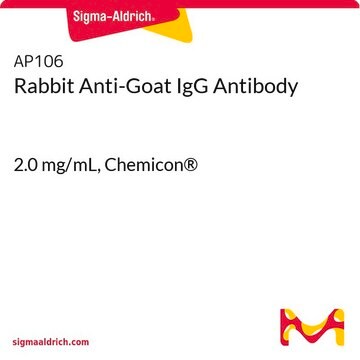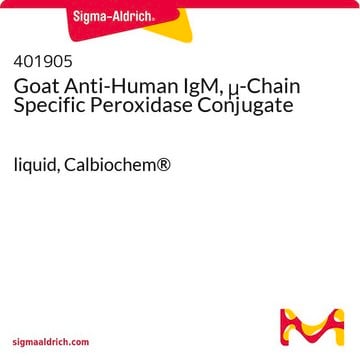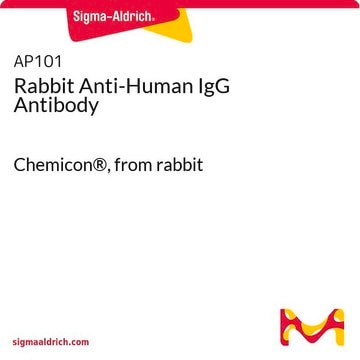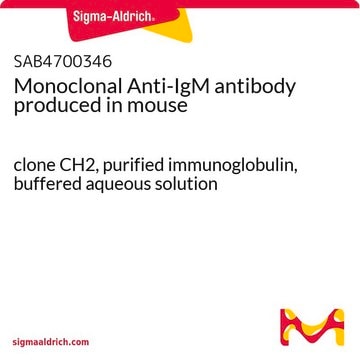Recommended Products
biological source
mouse
antibody form
purified antibody
antibody product type
secondary antibodies
clone
monoclonal
species reactivity
human
technique(s)
ELISA: suitable
immunodiffusion: suitable
isotype
IgG2b
General description
Secondary antibody specific for Human Immunoglobulin G
Immunoglobulin G (IgG), an immunoglobulin isotype, is the most abundant protein in human serum and constitutes 10-20% of plasma protein. It is composed of glycoproteins comprising 82-96% of proteins and 4-18% of carbohydrates. IgG is further classified into IgG1, IgG2, IgG3, and IgG4 subclasses. IgG consists of four polypeptide chains, with two heavy chains (γ chains) and two light chains (κ or λ chains), which are linked by inter-chain disulfide bonds. It is secreted by B lymphocytes and found in extracellular fluids and blood.
Immunoglobulin G (IgG), an immunoglobulin isotype, is the most abundant protein in human serum and constitutes 10-20% of plasma protein. It is composed of glycoproteins comprising 82-96% of proteins and 4-18% of carbohydrates. IgG is further classified into IgG1, IgG2, IgG3, and IgG4 subclasses. IgG consists of four polypeptide chains, with two heavy chains (γ chains) and two light chains (κ or λ chains), which are linked by inter-chain disulfide bonds. It is secreted by B lymphocytes and found in extracellular fluids and blood.
Specificity
Specific for Human IgG. No cross reactivity with human IgA, IgD, IgE or IgE.
Immunogen
corresponding to Human Serum IgG.
Application
Detect Human Serum IgG using this mouse monoclonal Anti-human IgG (1mg) KC, Cat. No. MABX1901-1KC, validated for use in Lateral Flow Assay and ELISA.
Biochem/physiol Actions
Immunoglobulin G (IgG) primarily contributes to the humoral immune response by neutralizing pathogens such as bacteria, viruses, and protect cells from their toxic substances. IgG is the only isotype transferred to the fetus across the placenta and is vital for immune response of the neonate. Alterations in IgG fragment crystallizable (Fc)-glycosylation are associated with various diseases including rheumatoid arthritis and tuberculosis.
Quality
Tested
Physical form
Format: Purified
Other Notes
Concentration: Please refer to lot specific datasheet.
Not finding the right product?
Try our Product Selector Tool.
Storage Class Code
12 - Non Combustible Liquids
WGK
WGK 2
Flash Point(F)
Not applicable
Flash Point(C)
Not applicable
Certificates of Analysis (COA)
Search for Certificates of Analysis (COA) by entering the products Lot/Batch Number. Lot and Batch Numbers can be found on a product’s label following the words ‘Lot’ or ‘Batch’.
Already Own This Product?
Find documentation for the products that you have recently purchased in the Document Library.
Customers Also Viewed
The N-glycosylation of mouse immunoglobulin G (IgG)-fragment crystallizable differs between IgG subclasses and strains.
de Haan N, et al.
Frontiers in immunology, 8, 608-608 (2017)
Noortje de Haan et al.
Frontiers in immunology, 8, 608-608 (2017-06-18)
N-linked glycosylation of the fragment crystallizable (Fc)-region of immunoglobulin G (IgG) is known to have a large influence on the activity of the antibody, an effect reported to be IgG subclass specific. This situation applies both to humans and mice.
Ratcliffe, M. J.
Encyclopedia of Immunology (2016)
Placental transfer of IgG subclasses in a Japanese population.
Hashira S, et al.
Pediatrics International, 42(4) (2000)
Gestur Vidarsson et al.
Frontiers in immunology, 5, 520-520 (2014-11-05)
Of the five immunoglobulin isotypes, immunoglobulin G (IgG) is most abundant in human serum. The four subclasses, IgG1, IgG2, IgG3, and IgG4, which are highly conserved, differ in their constant region, particularly in their hinges and upper CH2 domains. These
Our team of scientists has experience in all areas of research including Life Science, Material Science, Chemical Synthesis, Chromatography, Analytical and many others.
Contact Technical Service

